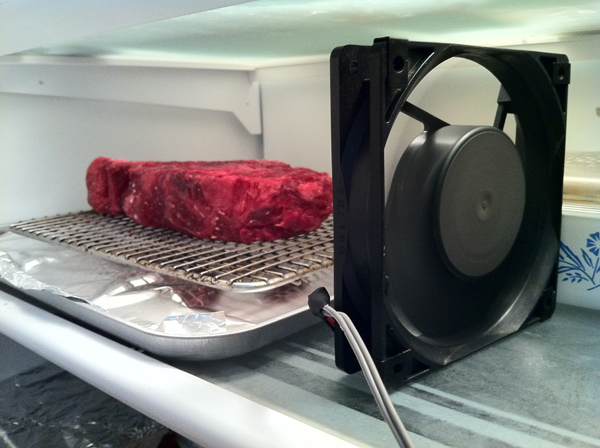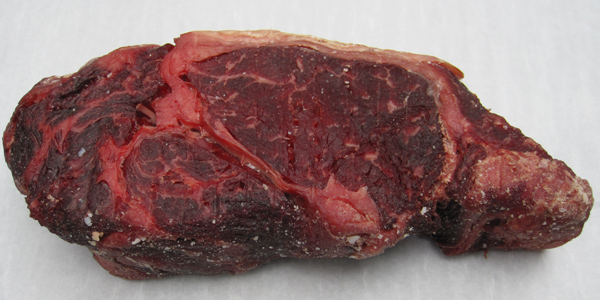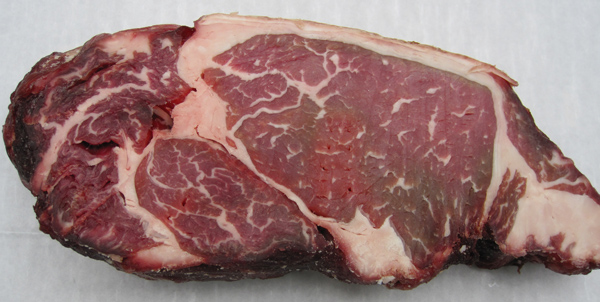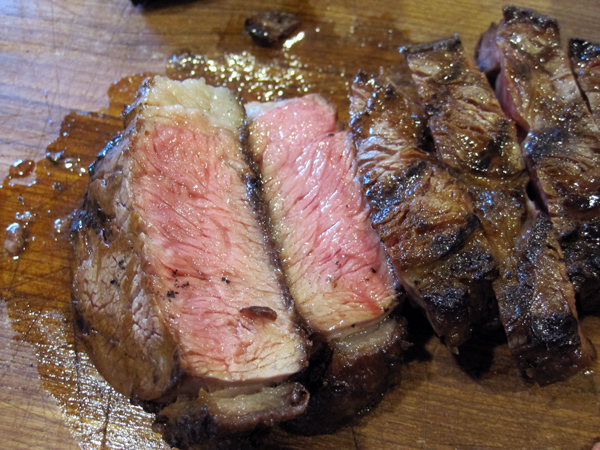| g e n u i n e i d e a s | ||||||
 |
 |
 |
 |
 |
 |
 |
| home | art and science |
writings | biography | food | inventions | search |
| dry aging meat |
|
September 2011 It's hard to reproduce the taste and texture of a dry-aged meat, perfectly grilled by a great steak house. The steak house has three advantages over the home cook. They have access to well-marbled meat that few butchers stock. They sear the steak above 800F, much higher than available in a typical kitchen oven or on most grills. And the steak is aged for two to four weeks, drying the meat, concentrating juices and most importantly, allowing controlled decay to produce deep, iconic flavors. But with a little work, we can match 2 1/2 of these 3 advantages. First, start with the steak. Prime rib-eye is a good choice, but few supermarkets carry this cut, with steak house quality. Find a local, independent butcher instead and become his best customer. Even he may have trouble obtaining true steak-house marbled meat, but you will get close. Second, shoot for high temperatures- by cooking over a roaring hot coal or wood fire. If you are going to the trouble and expense to dry-age steak, don't ruin the effect on a wimpy electric or gas range. I like to cook on a cast-iron flat top directly above the flames, but a grill grate with wide metal bars will do. So will cooking over a charcoal chimney as suggested at AmazingRibs.com Aging the meat is the third step. Take a prime (and pricey) steak and place it on a grate in the fridge. Make sure your fridge is spotlessly clean and odor-free. If you ever notice water condensation inside the fridge, the steak won't dry properly and you risk too much bacterial growth. Its a bigger problem in the summer months, or with hungry teenagers constantly raiding the fridge. Then, by cannibalizing an old DC fan from a computer, and a low voltage power supply with a narrow cord from some other junked electronics, blow air over the steak for three days, flipping once a day. The cord will slip under the magnetic rubber door gasket, and the tray is there to keep the meat clean- with this fan set-up, there are never any drippings.
After three days, this rib eye lost 17% of its original weight and developed a firm texture and crust. No off-odors at all. The white patches are exuded fats.
You can cook this meat right out of the fridge, and it will grill to a firm, dark flavorful crust. But its so dry, pre-salting is ineffective. Alternatively, using a thin fillet knife, remove the dried outer-layer from both sides of the meat. Then liberally coat with kosher salt, wait 30 minutes, anoint with oil or butter, and grill.
I grill for about 3 minutes a side at high heat, then place on an upper shelf in a cooler part of the grill (indirect heat below 300F) to let the steak rest and slowly warm up to 130F (medium rare). Experience, or a quality instant read thermometer, is your friend. Make sure to turn the steak a few times during this slow roasting stage- most grills are wildly non-uniform. Depending on the steak's thickness, about 15 minutes total cooking time.
Where is the missing "1/2" out of "3"? Well, after only three days of dry aging, the meat is firm and flavorful but lacks the more earthy tones produced by a month of controlled rotting in the presence of oxygen and enzymes like calpain. Still amazing, but not transcendent. Enjoy!
(another method to dry-age meat is discussed by Alton Brown) |
|
|
 Contact Greg Blonder by email here - Modified Genuine Ideas, LLC. |



